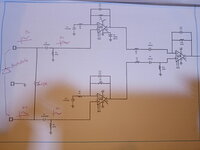umery2k75
Advanced Member level 1
Hello everyone,
This is the actual circuit made on a PCB and I couldn't get any stable results out from this circuit I injected Sin wave on the input of this amplifier instead of photodiode and I experiment with different frequency from 20Hz all the way to 1Khz Vpp 20mV to 1Vpp, but I couldn't get any meaning full result out from this. I really doubt if this is a proper engineering done, because transconductance amplifier are being used either in photovoltaic mode or photoconducive mode. Please shed some light on it.
This is the actual circuit made on a PCB and I couldn't get any stable results out from this circuit I injected Sin wave on the input of this amplifier instead of photodiode and I experiment with different frequency from 20Hz all the way to 1Khz Vpp 20mV to 1Vpp, but I couldn't get any meaning full result out from this. I really doubt if this is a proper engineering done, because transconductance amplifier are being used either in photovoltaic mode or photoconducive mode. Please shed some light on it.
